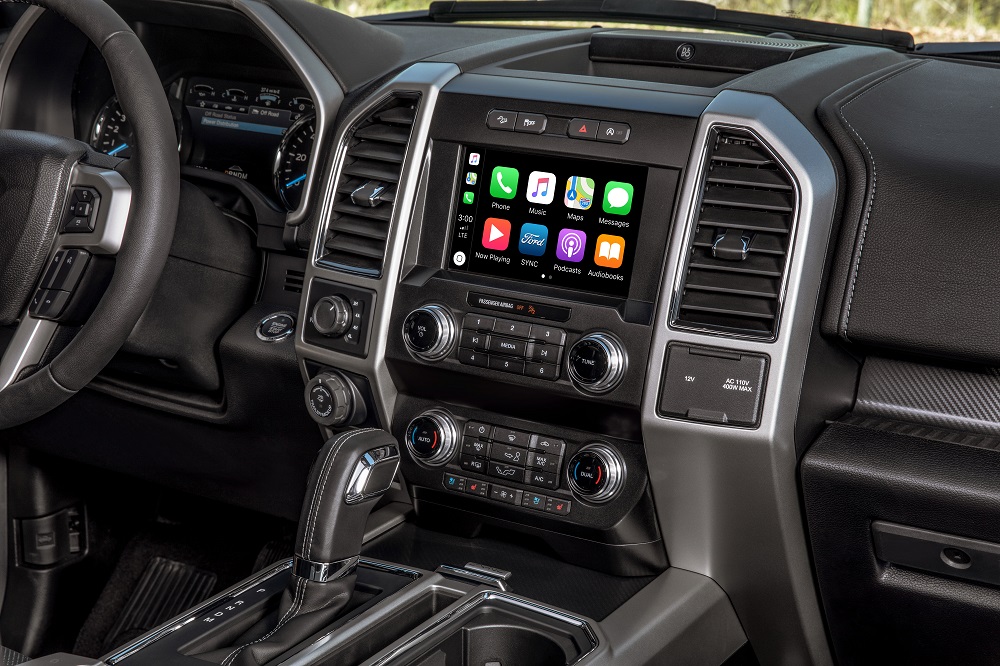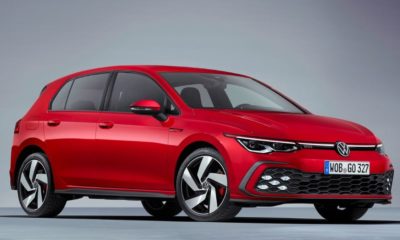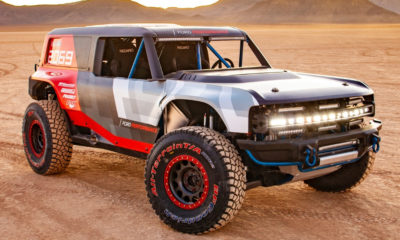Latest Car News
Ford F-150 Vs. Ram 1500
Pickup trucks have gone from work-ready rigs to family haulers over the past few decades, especially with models like the Ram 1500 and Ford F-150 offering more family-friendly cabins and features. While they have made this shift over the years, they retain their ruggedness and utility with excellent towing and payload capacities, and models ready to tackle the roughest trails.
While the Ram 1500 and Ford F-150 will check most of the want and need boxes for truck shoppers, one stands out as superior in a head-to-head competition. Find out which is the better pickup for you below.
Interior Comfort

2020 Ram 1500 Limited
Like all trucks, the 2020 Ford F-150 and 2020 Ram 1500 come in a wide variety of cab formats to meet various buyers’ needs.
At the base of most pickup truck lineups is a single-cab option that has no rear doors or seats, but the Ram 1500 lacks this option. The F-150, however, has this setup up in its regular cab model. In this format, you can squeeze three across its bench seat, which offers 40.8 inches of headroom, 43.9 inches of legroom, 66.7 inches of shoulder room, and 62.5 inches of hip room.
The next step up is the F-150’s SuperCab format that offers seating for five or six passengers, depending on the setup. The Ram 1500’s equivalent is the Quad Cab, which offers room for six passengers. The F-150 SuperCab’s front seats mimic the regular cab’s. The Ram 1500’s front seats offer an extra 0.1 inches of headroom and 0.9 inches of hip room, but they come up 3 inches short in legroom and 0.7 inches short in shoulder room.
The F-150 SuperCab’s rear seats are tight, but they work in a pinch with 40.3 inches of headroom, 33.5 inches of legroom, 65.8 inches of shoulder room, and 64.7 inches of hip room. The Ram 1500 Quad Cab comes up short in headroom by 1.1 inches, shoulder room by 0.1 inches, and hip room by 1.3 inches, but it offers an extra 2.1 inches of legroom.
The largest of the F-150 and Ram 1500 cabs are the SuperCrew and Crew Cab, respectively. The F-150 SuperCrew and Ram 1500 Crew Cab have the same front-seat measurements as their SuperCab and Quad Cab variants. The big difference is in their rear seats, as these models have the room to haul even the largest of crews to the worksite or the office.
In the rear, the F-150 offers 40.4 inches of headroom, 43.6 inches of legroom, 65.9 inches of shoulder room, and 64.7 inches of hip room. The Ram 1500 beats the F-150 in headroom and shoulder room by 0.5 and 0.1 inches, respectively, but it comes up short in legroom by 2.7 inches and hip room by 1.3 inches.
Because legroom is what matters most in interior measurements, it’s clear that folks who use the rear seats to haul adults often will find more useful space in the F-150 SuperCrew. Those who don’t want the heft of four full-size doors but still need roomier rear seats for occasional use will find a nice balance in the 2020 Ram 1500 Quad Cab.
Performance

F-150 3.0-liter Power Stroke Diesel V-6
If you want engine options, the 2020 Ford F-150 is the rig for you. It has six options in total, and they range from timid to wild to meet just about any buyer’s needs.
At the bottom of the F-150 lineup is a 3.3-liter V-6 engine that delivers 290 horsepower and 265 pound-feet of torque. With this engine, the F-150 can tow up to 7,400 pounds. The base Ram 1500 uses a 3.6-liter V-6 with a mild-hybrid setup that delivers 305 horsepower and 269 pound-feet of torque. With the base engine, the Ram 1500 beats the F-150’s towing capacity by 310 pounds.
The Ford F-150’s next engine in line is a 2.7-liter twin-turbocharged V-6 unit that delivers 325 horsepower and 400 pound-feet of torque. This engine delivers strong acceleration and offers the power to tow up to 8,500 pounds. The Ram 1500 has no equivalent to this toque-heavy engine.

2020 Ram 1500 – 5.7-liter V-8 with eTorque
V-8 engines are still a thing in pickup trucks, and the F-150 and Ram 1500 each offers one. The F-150 uses a 5.0-liter V-8 that delivers 395 horsepower and 400 pound-feet of torque, which helps this pickup tow up to 11,100 pounds. The Ram 1500 boasts the tried-and-true 5.7-liter HEMI V-8 with 395 horses and 410 pound-feet of torque that helps it pull up to a 12,750-pound trailer, which again beats the F-150.
Diesel engines are making a comeback in light-duty pickups, and the F-150 and Ram 1500 each have one. The F-150’s diesel unit is a 3.0-liter Power Stroke turbocharged V-6 that pounds out 250 horsepower and 440 pound-feet of torque. With this torque diesel unit, the F-150 tows up to 11,400 pounds. The Ram 1500’s diesel option is a 3.0-liter EcoDiesel turbocharged V-6 that injects 260 horsepower and 480 pound-feet of torque for a 12,560-pound towing capacity.
The Ford F-150 again separates itself from the Ram 1500 with two more twin-turbo V-6 engines. These are both 3.5-liter units, and the standard unit delivers 375 horsepower and 470 pound-feet of torque. The high-output unit, which is standard in the F-150 Limited and Raptor, injects a whopping 450 horsepower and 510 pound-feet of torque.
With the standard 3.5-liter turbocharged engine, the F-150 tows up to 13,200 pounds. Because the high-output engine sees use in models that are not ideal for towing, its max trailer-hauling is limited to 11,100 pounds.
Other than the diesel engine, which uses a six-speed automatic, the entire F-150 lineup uses a 10-speed automatic transmission. The Ram 1500 lineup features several variations of an eight-speed automatic transmission.

Both models boast off-road-ready models. The F-150 has its Raptor model that features FOX racing shocks, heavy-duty skid plates, a higher ride height and suspension travel, and Normal, Baja, Rock Crawl, Sport, Mud-Sand, Wet-Snow and Tow-Haul driving modes. The Ram 1500’s Rebel model is also off-road ready, but it is not quite as rugged as the Raptor with its standard two-wheel drive and 3.6-liter V-6 engine.
Fuel Economy

2020 Ram 1500 Big Horn
In base fuel economy, the F-150 with the 3.3-liter delivers up to 19 mpg city, 25 highway, and 22 combined. The base Ram 1500’s mild-hybrid 3.6-liter delivers up to 20 mpg city, 26 highway and 23 combined in its HFE variant.
With V-8 power, the F-150 offers up to 17 mpg city, 23 highway, and 19 combined. The Ram 1500 with the 5.7-liter HEMI V-8 delivers up to 15 mpg city, 22 highway, and 17 combined. There is also a mild-hybrid version of this V-8 that boosts its thriftiness to match the F-150.
As for the diesel powertrains, the EPA has not released fuel-economy ratings on the oil-burning 2020 F-150 yet, but the 2019 model delivered 22 mpg city, 30 highway, and 25 combined. The Ram 1500 EcoDiesel, on the other hand, delivers up to an impressive 22 mpg city, 32 highway, and 26 combined.
The F-150 offers an extra wrinkle with its turbocharged V-6 engine options, as the 2.7-liter engine delivers up to 20 mpg city, 26 highway, and 22 combined. The standard 3.5-liter turbo engine offers up to 17 mpg city, 23 highway, and 19 combined. The high-output 3.5-liter’s is slightly lower at up to 17 mpg city, 22 highway, and 19 combined in the Limited model.
Features

2020 Ram 1500 Limited – Black Interior
While the Ram 1500 and Ford F-150 each has its own respective stripped-down work truck in the Tradesman and XL trims, most retail buyers will move up one slot into the Ram 1500 Big Horn and F-150 XLT.
The Ram 1500 Big Horn starts from $36,540 and includes the 3.6-liter V-6 engine, automatic on/off headlights, daytime running lights, cargo area lights, power mirrors with heat, chrome bumpers, manual air conditioning, power locks, variable-intermittent windshield wipers, power windows, steering-wheel-mounted controls, illuminated vanity mirrors, a tilt-and-telescoping steering wheel, cloth seating, carpeted floors, a leather-wrapped steering wheel, a six-speaker audio system, a 5-inch touchscreen, and more.

The Ford F-150 XLT starts from $34,510 and comes standard with most of the same features as the Ram 1500 Big Horn, plus the 3.3-liter V-6 engine, fog lights, Ford MyKey, a keyless entry keypad, the SYNC 3 infotainment system, an 8-inch touchscreen, Apple CarPlay, Android Auto, AppLink, two smart-charging USB ports, 4G LTE Wi-Fi capability, app-based remote locking, unlocking and ignition, a four-speaker audio system, and automatic emergency braking.
Both models offer premium models higher in their respective trim levels in the F-150 Limited and Ram 1500 Limited.
Which is Best For You

Until the EPA tests the 2020 F-150 diesel, the Ram 1500’s 32 mpg highway is superior in fuel economy, making it the better option for commuters who also want to haul a trailer. That said, the F-150 is better than the Ram 1500 in virtually every other way, including its robust powertrain options that meet the needs of virtually any buyer, peak towing, and its number of cab options.
On top of its versatility, the F-150 also boasts more standard tech features in its retail-friendly XLT model, including popular bits like Apple CarPlay, Android Auto, and automatic emergency braking. These are all options on the Ram 1500.






















You must be logged in to post a comment Login